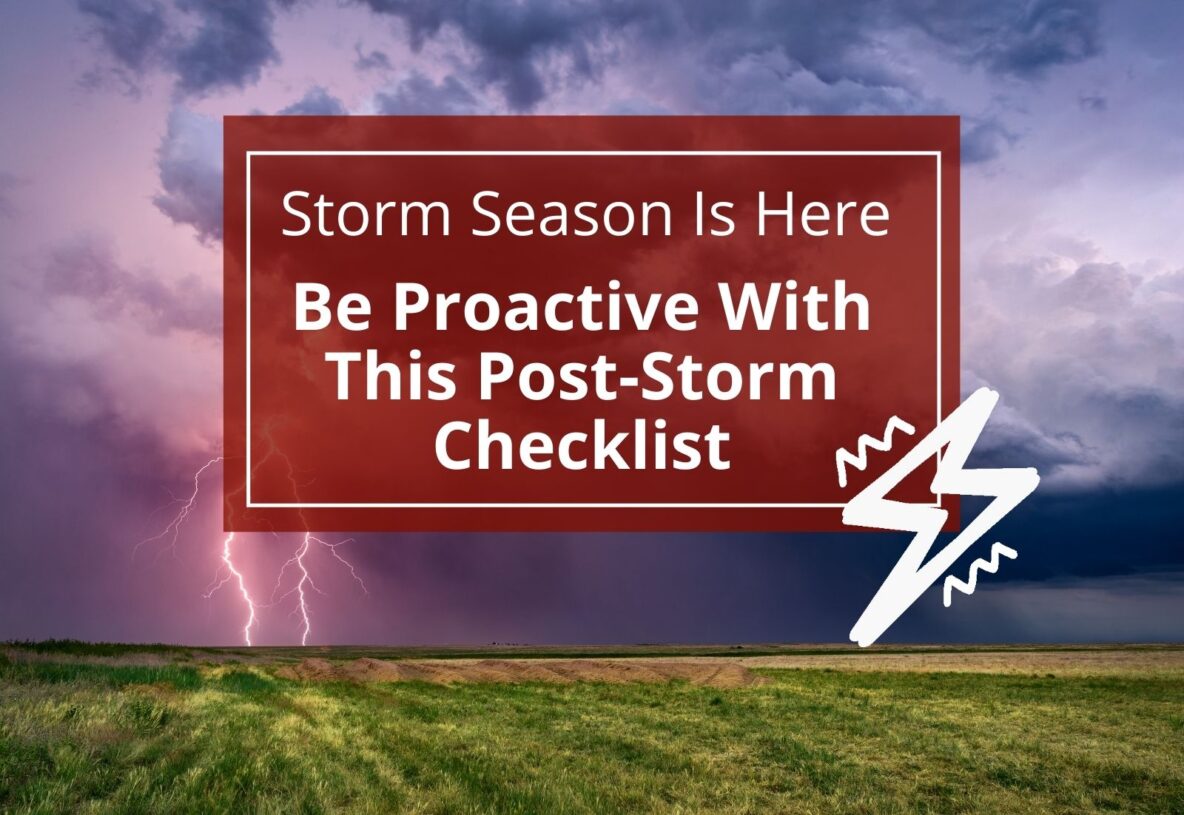This is the time of year we daydream about during the long, cold winter months. It’s safe to say that most of us live for Minnesota summers. Of course, all seasons have their forces to contend with and summer is no exception. It might not be snowstorms, blizzards and sub-zero temps but an occasional tornado and frequent thunderstorms with their high winds, rain and hail can wreak havoc on our homes and businesses.
In the wake of a big storm, it can feel a little scary and overwhelming:
What kind of damage did my home or building sustain? How can I be sure the envelope of my structure is still safe and intact? Should I call my insurance company? What can I do to tighten up my home or building’s envelope so the next storm doesn’t cause even bigger issues?
That’s why we put together this post-storm checklist for homeowners and property managers. Keep it in a convenient place so you can run through the checklist after the next big storm sweeps through your area.
Post-Storm Checklist – Interior Tasks
☑️ Inspect your ceiling for water damage
Interior water damage can be discreet and impossible to observe simply from the outside of your home or building. Walk through each room and carefully inspect the ceiling. Use a flashlight to fully illuminate the ceiling’s surface. Look for signs of staining. Water stains can appear as large blobs or small splotches. Older stains will appear darker. If you see lighter spots around an old, dark stain, this is an indication that there is also recent water damage. Touch any stains you find to see if they’re firm or squishy. This will help you determine how long they’ve been there. If the stain feels firm, it probably means you caught the water damage early on.
☑️ Inspect your attic for water intrusion
If you can, go up in your attic with that same handy flashlight and inspect the ceiling, joints and around any roof penetrations. Climbing around in the attic isn’t pleasant but catching water intrusion before it becomes a bigger problem is well worth the hassle.
Post-Storm Checklist – Exterior Tasks
☑️ Inspect your roof
Begin by looking for signs of damage from the ground. Is there any roof debris around the base of your property? Look for shingles that may have blown off or shingle granules on patio furniture, the driveway or sidewalk. Are there any pieces of brick from the chimney or metal flashing lying on the lawn?
If you’re comfortable climbing up on your roof, inspect the following:
- What condition is the roof in? Do you notice any new punctures, gaps, missing shingles or tar paper, tile, slate, etc?
- Did the storm leave debris on your roof? Clear off debris before it traps moisture, tears up your roof’s surface or becomes a home for birds or squirrels.
- How does the chimney look? Is it crumbling a little more with each heavy rain?
- Inspect flashing around all exterior roofing penetrations. Is it tight and secure or loose, gapping or missing?
- Do seams look tight or are they gapping?
- Do you notice any water stains, pooling water or sagging spots on your roof’s surface?
☑️ Inspect gutters and downspouts
- While you’re on the roof or up on the ladder, make sure gutters are clear so water can drain properly off the roof and away from your structure.
- Check joints where gutters and downspouts meet and make sure they’re secure.
- From the ladder or the ground depending on the height of your home or building, make sure all downspouts are securely fastened to the building and all pieces are securely connected.
☑️ Inspect window glass and screens
- Walk around your property and inspect all exterior windows and doors. Is there any sign of visible damage such as cracked, spidered or shattered glass or doors that are loose or torn off the hinges from blowing in the wind? Be sure to pay special attention to screens and make note of any ripped or sagging screens that could use repair.
- Make sure to check window and door frames for cracks. This is a common place for water to sneak into your walls which can lead to rot and mold issues down the road.
☑️ Inspect the perimeter of your home or building
- Do a once-around inspection of your structure. Are there any places where siding is coming loose?
- Are there any cracks in your foundation that you haven’t noticed before?
- Again, keep an eye out for debris on the ground that could have come loose from your walls or roof. Small pieces of siding or roofing materials can be indicative of larger problems that you’ll want to address right away.
Are you thinking about filing a storm damage insurance claim? Then check out our post, Tips for Storm Damage Insurance Claims, to help you navigate the process!
Remember, you don’t have to perform any of these tasks on your own. Many people prefer to call a professional to do the “dirty work” for them. At Hoyt Exteriors, we have experience assessing envelope integrity after a storm, working with insurance companies on insurance claims and performing exterior siding, roofing, window and door repair or replacement.
Contact us at 612.212.4965 to learn how we can help!

